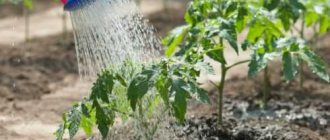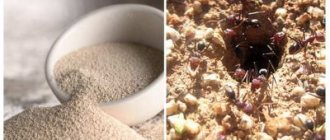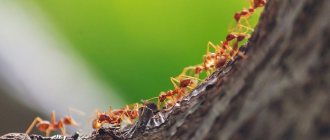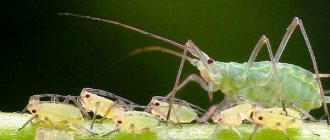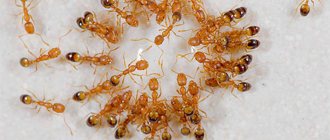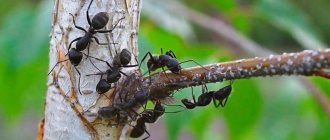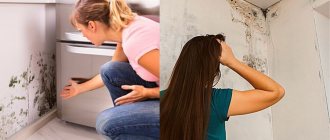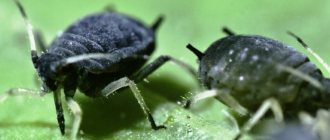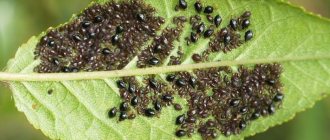Folk remedies for aphids are of great practical importance. First of all, because they are absolutely safe, and secondly, they work perfectly as preventive means of protecting plants from pests. As a rule, they are used in the later stages of the vegetative development of the plant, during the ripening of vegetables, berries, fruits, i.e. when the waiting period before harvest does not allow the use of chemical pesticides.
Aphids have many varieties, prefer to live on almost all cultivated plants - vegetables, berries, and fruits, and cause enormous damage. In a separate material on the website you can find information about what it looks like, where it lives, why it is dangerous, what are the features of its development and behavior .
Risk factors associated with aphid infestation of plants
This material contains a selection of the best and, most importantly, effective “folk” remedies for aphids.
Reasons for the appearance of aphids in the garden
With the beginning of spring, many gardeners begin to notice the presence of parasites such as aphids in their plantings. Of course, they are interested in where such a misfortune comes from. The main reason for the appearance of aphids in summer cottages is:
- purchasing and planting infected plants,
- wind transfer of insects from neighboring areas,
- transfer of larvae by ants, on animal fur or by people themselves,
- soil damage by aphid larvae brought from other areas,
- lack of timely measures taken for processing in the garden or vegetable garden.
Tar soap
Birch tar is a natural insecticide for pests. The remedy for aphids on plants is safe to use. Pure tar is difficult to find, but soap is sold.
If a natural component is found, then a solution is prepared from the following ingredients:
- 300 ml soap: laundry or cosmetic;
- 10 liters of tap water;
- 100 ml of tar concentrate.
All components are mixed. Leaves are treated with the composition against aphids. But tar soap is more common in stores. Prepare the solution in the same way as in the traditional method with laundry soap. The pungent aroma will remain on the plants for a long time and will repel pests. An excellent option for those who do not know how to kill aphids.
Experienced gardeners do not recommend spraying the solution during the flowering period. Bees, like aphids, will be frightened by the strong smell, and pollination will not occur. The method is suitable for processing in the early stages.
How to treat flowers against aphids? It is best to use tar soap, but follow the above recommendations.
What types are there
This pest can be easily identified by these signs:
- Soft and translucent body without chitinous cover;
- The color of the insect completely depends on the plant on which it parasitizes, so there are black, green or white shades;
- The size does not exceed 2 mm;
- Body shape directly depends on the type of insect;
- The body of each insect is decorated with soft short fluff, and minor asymmetrical tubercles perfectly complement the appearance of each individual;
- Some insects have wings;
- Due to the presence of thin and long legs, aphids can crawl or jump, and the organs of touch are small antennae;
- Often individuals do not have distinct sexual characteristics, but there are some specimens that have received the gene responsible for such a mutation. Thanks to it, it is possible to accurately determine whether a female or a male is in front of the student.
During the winter, aphids lay eggs, from which new individuals hatch in the spring. It is not of fundamental importance for these insects to parasitize young seedlings, seedlings or trees. Scientists identify the following types:
- green, often found on seedling sprouts,
- white, affecting indoor plants,
- black or universal,
- floral, so named because of its habitat preference.
Why are aphids dangerous?
Insects are tiny in size - 0.3 - 0.8 mm, the main pest of gardens and gardens. Aphid colonies
settle on leaves, stems and roots of plants and are highly fertile. The main weapon is a piercing proboscis, with which the aphid pierces the surface of the leaves, sucking out the juice.
Aphids feed on plant sap
, sucking out cell sap. Young plants especially suffer from the poison released by the pest; the leaves curl, become deformed and die.
The growth of shoots stops, the tops become bent. Sweet secretions left by aphids contaminate the surface of the leaves, thereby disrupting the normal functioning of plants.
This sweet secretion serves as a bait for ants
, so they can always be seen next to plants on which aphids have settled.
With their saliva, aphids infect plants with viruses, causing extensive damage in gardens. Aphids cause the most damage to young tree seedlings.
In one summer season, this pest is capable of producing up to 50 generations of offspring, which will cause irreparable damage to any summer cottage.
The best way to protect trees from ants and aphids
, sticky fly tape. Wrap the trunk of an apple tree or other tree until the ants carry the aphids onto the tree. And you can forget about these pests for a whole year.
Signs of aphids
Affected plants cannot produce a good harvest, so most gardeners are interested in the question of signs of damage to green spaces by aphids. Depending on the type of insect, the following signs of damage can be identified:
- the plant begins to dry out,
- its leaves begin to turn yellow and curl into a tube, resembling a house,
- underdevelopment of fruits,
- deformation of branches,
- sticky film of white or yellowish color on the surface of buds and leaves.
The active breeding period for aphids is considered to be the beginning of summer. The offspring appears in this case with wings, which allows them to cause colossal damage to all nearby plants. Insects move from a dead bush to a nearby healthy bush and destroy it.
Symbiosis with ants also contributes to the spread of aphids throughout the area. The insect secretes honeydew, which ants adore. To get more sweet liquid, ants guard and transfer it to another territory. When ants appear on their site, many gardeners begin to carefully check the plantings for the presence of aphids.
Method No. 2 Folk remedies
Folk remedies for fighting aphids
Folk remedies for combating these insects mainly consist of spraying the leaves of affected plants with various infusions or decoctions, as well as mechanical and agrotechnical methods of control.
Using infusions
Folk remedies for fighting aphids
This is the simplest, but very effective method of killing insects. It is also not harmless, since high concentrations of certain substances can cause burns in plants and be toxic to both plants and humans.
The use of such a method must be accompanied by compliance with certain rules. In particular, it is recommended to test its effect on a limited area before mass use of a particular composition.
Such products are used once a week. During the periods of flowering and harvesting, their use is acceptable, although undesirable. Application to leaves affected by aphids is done by spraying. This can be either a manual sprayer or a semi-professional sprayer with a pump. It is best to spray in cloudy weather in the evening.
It is possible (but not advisable) to apply the preparations using another means, for example a brush, but their impact will be significantly lower. Any of the listed solutions is effective only when applied evenly to the surface.
Many of these solutions contain soap. This component is required for the following functions:
- Used as an adhesive, “gluing” the surface of the sheet and the active substance, so that it is not washed off with water
- Creates a thin layer of film on the leaves, making them rougher, making it difficult for aphids to pierce them
- Upon contact with the body of an aphid, soap penetrates its trachea, making it difficult for the insect to breathe
Let's look at the most successful recipes for infusions against aphids:
1 Soap solution
Finely chop 100 g of onion and add 2 liters of water, let stand for 3 to 7 hours. Add about 10 g of soap to the resulting infusion.
2 Soap-iodine solution
Dissolve 2 caps of iodine in 5 liters of water and add 50 g of soap shavings (grate on a fine grater). It is recommended to use the mixture no later than half an hour after preparation.
Soap and soda solution
3 Soap and soda solution
Dissolve 2 tablespoons of baking soda (or 1 tablespoon of soda ash) in 2 liters of water. Then rub 15-20 g of laundry or tar soap on a fine grater and add to the mixture. Stir until completely dissolved. This is one of the most effective and long-lasting remedies (about a month), since the presence of sticky drops of soap will help keep the soda on the leaves and stems. Sometimes 30-50 ml of finely crushed wood ash (so-called ash-soap solution) is added to the composition.
4 Soap solution with chamomile
Dry pharmaceutical chamomile (100 g) is poured with a liter of water and left for 12 hours. After this time, another 1 liter of water and 5 g of soap are added to it.
In addition, pepper, dandelion, and marigold infusions are used. For this purpose, 350-400 g of dried stems of the listed plants are used per 1000 ml of water. They can be either with the addition of soap (4-5g per 1 liter of infusion) or without it. Soap containing birch tar is best suited for this purpose.
5 Soapy alcohol solution
Depending on which plants the alcohol mixture is applied to, its recipes may vary. So, for trees the following composition is used:
Add a bottle of vodka (or 200 ml of alcohol) and 30 g of soap shavings to 3 liters of water.
For roses, ornamental and vegetable crops, it is recommended to reduce the amount of vodka to 100 ml, leaving other components in the same quantities.
For indoor plants, a more complex recipe is used: 300 ml of refined vegetable oil, 200 ml of vodka and 20 g of soap are added to 2 liters of water. In this case, the oil acts as a thin film covering the surface of the leaf and preventing aphids from breathing.
6 Vinegar solution
Dissolve 15-30 ml of vinegar essence (or 200-300 ml of 9% table vinegar) in 10 liters of water. Then 50 g of soap shavings are added to the mixture.
7 Hydrogen peroxide
An effective remedy not only against aphids, but also mealybugs and scale insects. Particularly effective for treating indoor plants.
Compound:
- hydrogen peroxide 3% – 50 ml;
- vodka – 2 teaspoons ml (or alcohol – 1.5 tsp);
- dishwashing liquid – 1 g;
- water – 1 l.
The mixture should be used within 10-15 minutes after preparation; it cannot be stored longer.
Garlic water
8 Garlic solution
Garlic cloves (100 g) are finely chopped and immersed in 500 ml of water, allowing to brew for about 72 hours. Before you start treating the plants, you need to dilute a solution of garlic cloves in water in a concentration of 300 to 1.
9 Tobacco leaves
Dried tobacco stems and leaves weighing 100 g are finely chopped and poured into 3 liters of water for 48 hours. At the end of the infusion, you need to add another 2 liters and spray the affected plants with the resulting solution. This solution can also be made ash by adding 100 ml of wood ash to it.
10 Pine needles
Pine needles in an amount of 2 kg are filled with water (one bucket). The infusion requires regular daily stirring for a week. At the end of this period, you need to add the same amount of water to the container and use it for spraying.
11 Citrus infusion
Aphids do not tolerate the smell of citral aldehyde well, so they are well repelled by any aromatic or essential oil from the peel of citrus fruits. Dried peel of lemon, orange, and other similar crops in the amount of 100 g are infused in 1 liter of water for 3 days.
The product has high chemical activity, so it must be used in small doses. To treat one plant up to 2 m high, use approximately one glass (230-250 ml) of this liquid product.
Citrus tincture
12 Nightshade infusion
Nightshade leaves and shoots (1 kg) are finely chopped and immersed in 10 liters of water for at least 3 hours. Can be used as an independent remedy or in a 1 to 1 mixture with a soap solution.
13 Infusion of sorrel root
200 g of sorrel root is immersed in 3 liters of hot water, where it is infused for at least 3 hours. Since the main component of the product is an acid, it is not recommended to mix it with soda or soap.
14 Acid-ammonia solution
It has a quick action time, although it is completely inapplicable for prophylaxis. This product works great on roses and rose hips. Helps fight aphids also on currants and other ornamental bushes.
Compound:
- 2% salicylic acid solution – 25 ml;
- ammonia alcohol – 15 ml;
- water – 500 ml.
All components are mixed until smooth, and then the affected plant is sprayed. Immediately before treating the plant and 30 minutes after that, it is subjected to sprinkling.
15 Use of natural pyrethroids
Dalmatian chamomile leaves contain a large amount of natural insecticides that will be effective at all stages of insect development. To preserve these abilities, it is not recommended to heat treat the leaves and buds of the plant. They should be dried and thoroughly crushed. Then the crushed leaves are poured with water and allowed to brew for about a week. For 1 liter of infusion, 5 tsp is enough. dry chamomile leaves.
Before use, strain the infusion and add a little soap to it. You can also prepare a remedy from fresh leaves, for which they should first be doused with boiling water, and only then crushed and filled with water. This will require approximately 3 times the amount of biomass.
When growing independently, it is recommended to plant Dalmatian chamomile on the leeward side of the site.
Prevention when using solutions
Garlic for aphids - application
Low concentration infusions can act as a prophylactic agent. They are used by diluting with water in a ratio of 1 to 1. For prevention, it is recommended to treat the stems and leaves of the plant once a week.
Soap-containing solutions remain on the leaves for a much longer time. They are recommended to be used for prevention once every two weeks.
Use of decoctions
Preparation of a decoction of celandine
Decoctions are more effective because they contain an even higher concentration of active substances. Their harmful effects will be even greater than those of infusions, however, the effect will also be more significant. Decoctions are used in particularly advanced cases, when the population of aphid colonies is high.
Recipes for the most common decoctions:
- The stems and flowers of freshly collected celandine (800 g) are immersed in 2 liters of water and infused for 24 hours. Next, the resulting mixture is boiled for half an hour
- One hundred grams of dried tobacco leaves are poured into 3 liters of water and left for a day. Next, add another 2 liters of liquid to the infusion, bring it to a boil over low heat and leave for another 2 hours.
- Nightshade stems and leaves in an amount of 500 g are placed in a 3-liter container with boiling water. Boiling is continued for about half an hour. Pour another 5 liters of water into the resulting broth and add 30 g of laundry soap.
- It is also possible to prepare a similar mixture from potato peels, but it will require 2 times more than tomato tops in the previous version
- A decoction of onion peels is prepared in a similar way. It is taken in an amount of 600-800 g and placed in 3 liters of boiling water. Boiling is carried out for 15-20 minutes, after which the husks are thrown away, the broth is filtered, diluted with another 3 liters of water and 50 g of soap shavings are added.
- One hundred grams of hot pepper fruits are boiled for 60 minutes in 1 liter of water. The resulting mixture needs to be infused for two days in a warm and cool place. After infusion is complete, the concentrate is filtered and diluted with water in a ratio of 1 to 10. It is also recommended to add 5 g of soap to the resulting composition
- Dried yarrow in the amount of 500 g is poured into 1 liter of water. The resulting composition should be placed in a water bath for half an hour, then add another 4 liters of water and leave for 24 hours
Other methods
Aphids on roses
Mechanical methods are used when the aphids are still small (3-4 lesions with several dozen individuals). They involve manually collecting insects and their eggs or cutting and destroying affected leaves.
For indoor flower plants at home, traps are used - protection from aphids in the form of a barrier on the stems. As such a barrier, special adhesive tapes with a width of 40 mm or more are used. There are also wider adhesive tapes that fit onto the trunks of large trees. Such remedies will be effective only at the beginning of the season, while insects do not have wings for flight.
Agrotechnical methods (weeding beds, loosening, killing weeds, introducing ash into the soil, fumigating with sulfur, etc.) should be carried out regularly at least once a week. Mulching eliminates these procedures for an additional week. Do not forget to sprinkle crops from time to time - a stream of water from the plants can wash away most of the aphid colonies.
It is important to remember that watering plants with cold tap water from a hose is also not recommended - they weaken and lose immunity not only to aphids, but also to other malicious pests.
Sometimes methods are used to repel aphids by scattering various substances with a pungent odor on the site. In particular, it is recommended to place bay leaves in the spaces between the rows of the beds where bell peppers or various types of cabbage grow. Instead, shag can be used; it is also recommended to pollinate the plants with dry tobacco dust, use dried dandelion powder, etc. But the effectiveness of such methods will be low, since over time the smell will disappear and the repellent material will have to be constantly updated.
What harm does aphids cause?
It can destroy any plants, which is why gardeners spend so much time fighting this pest. The colossal harm caused by these insects is very difficult to even imagine. Thanks to aphids, irreversible deformation of leaves and shoots occurs. The condition of the crops grown is noticeably deteriorating. The pest sucks out the nutrient fluid, without which the crop cannot develop and bear fruit.
When affected, widespread fungal diseases can be observed. Plants noticeably weaken. During the cold period, such a planting very often simply dies, not having the strength to cope with weather conditions. There is no need to talk about productivity when affected by aphids. At best it will be meager, but most often the crop does not bear fruit.
Types of aphids and their negative effects
Green aphid
About a third of all aphid species live in Eurasia. The following species are most widespread on the European continent:
- green;
- black;
- cotton;
- Helichrysaceae.
Description of varieties
Black aphid
Representatives of green aphids can be found on any plant. These parasites prefer fruit trees and shrubs, as well as large perennial flowers and herbs. Among garden crops, green aphids mainly attack nightshade plants - they can be found on potatoes and tomatoes.
Black aphids live in vegetable gardens, attacking any low vegetation - from beets to legumes. In addition, aphids attack berry crops and some ornamental plants. Moreover, these crops may not have a garden “registration”. For example, black aphids readily feed on the juice of physalis and tuberous flowers (irises, callas); its larvae can be found on the tender leaves of anemones.
Cotton aphids are also an inhabitant of the vegetable garden. The result of her activities is low yields of melons and pumpkin crops.
Cotton or melon aphid
The cotton aphid poses a particular danger to cucumbers.
Helichrysous aphid
The Helichrys variety prefers crops with large seeds. Trees of the Prunaceae family - plum, sloe, cherry plum, etc. - are primarily at risk. Representatives of this species also suck juice from apple trees, peaches, apricots, viburnum, and linden.
Aphid migration methods
Aphids on garden plants
During the season, aphids do not migrate. Towards the end of summer, the first males appear in aphids and subsequent generations may contain both wingless and winged insects that are already capable of flying from plant to plant.
One of the last generations of aphids, immediately after migrating to a new place, lays eggs, which overwinter and insects emerge from them in the spring, occupying a new “territory.”
Damage from aphids
Large pest colony
Aphids pose a danger to young plants and shoots. By sucking out nutrients and cell juices, it can significantly weaken the plant and slow down its growth rate. In addition, aphid saliva is poisonous to the plant (moreover, it is not the secretions themselves that are poisonous, but the toxins of the fungi that appear on the plants thanks to it).
Its negative impact is complex:
- plant foliage curls and becomes deformed;
- shoots die;
- growth stops.
Viral and fungal diseases can be transmitted from plant to plant through the saliva of aphids. Infections with viral diseases in 90% of cases occur due to aphids. Ants, picking up the sweet secretions of aphids (honeydew) and feeding on them, themselves become carriers of the virus on their paws. Aphids also harm bees, since they can collect its honeydew, mistaking it for nectar.
If you do not use any methods of action against aphids, after 2-3 generations you can forget about a good harvest. Let's look at the various methods for controlling aphids currently in use.
How to get rid of aphids forever
Most gardeners look for universal remedies against aphids on Internet forums, but often a remedy that is effective in one case will give mediocre results in another.
Purchased funds
By purchasing aphid preparations in specialized stores, you can completely get rid of this pest. Getting rid of parasites of this type is possible thanks to chemical, biological or folk remedies. They differ in their operating principles, but their results are almost the same.
Chemical
Using insecticides, you can get rid of aphids and their larvae, as well as eggs. The main disadvantage of chemical control is the negative impact that will have on the plant itself. The use of this type of effective means should be approached very carefully and carefully, following all the manufacturer’s instructions indicated on the packaging. Among the most popular drugs to combat parasites:
- "Aktara"
- "Inta-Vir"
- "Tanrek"
- "Decis Profi"
- "Commander"
- "Prestige",
- "Koragen"
- "Double effect"
Some of these products will be effective when treating a specific type of planting, while others have a universal effect. Insecticides can be treated before bud formation begins. During this period, the use of such drugs has the most powerful effect,
Biological
This type of anti-aphid remedy includes fungicides, which have proven themselves to be quite good at killing pests. The most popular drugs in this case will be:
- "Jaguar",
- "Aktofit"
- "Fufanon"
- "Entobacterin"
- "Fitoverm".
It is better to start treatment with these drugs in the morning or evening. Treatment is most effective in calm and windless weather. The procedure must be carried out no later than one week before harvest. It is important to take into account that, like any other living organism, aphids develop immunity to the substances used against them, so treatment must be carried out by changing the preparations.
Traditional methods
Many folk remedies help get rid of garden pests. For example, crops affected by aphids, characterized by hard and dense leaves, can be eliminated from their harmful neighborhood using ordinary water. Regular summer showers or watering will wash away parasites. They won't be able to climb back. In this case, water must be supplied from a hose under pressure.
A rather concentrated product that must be used very carefully is tobacco infusion. To do this, pour boiling water over tobacco leaves or ordinary shag and leave for a day. If it is not possible to purchase such ingredients, you can completely replace them with ordinary cigarette butts. The resulting composition must be filtered and sprayed on the plants. You can spray the plantings at any time, but no later than a week before harvest.
Aphid baits and traps
Baits and traps will provide reliable protection against aphids. One type of effective trap for these pests is a sticky belt. This device is placed under a bush or tree, which will not make it possible to get to the plantings.
Ants can come to the aid of aphids. To neutralize such “helpers,” you need to mix a spoonful of minced meat with ground borax and place the mixture near the anthill. Once caught in such a trap, insects die within 5 hours.
Soap solution for aphids
You need to dissolve 5 tablespoons of liquid soap or detergent in a liter of water. In case of emergency, you can even use washing powder. You need to choose detergents without fragrances, as this will only attract aphids. Each plant is carefully treated with this composition using a sprayer.
If you have tar soap on your household, rub it on a grater and dilute it in a liter of warm water. After this, you need to add a little soda. The resulting solution is used to treat the plantings according to the method described above.
Ash from aphids
Ash is also great for fighting aphids. A glass of it can be diluted in 5 liters of water, left for 12 hours and processed. If necessary, the procedure is repeated after a couple of weeks.
Methods for controlling aphids
There are quite a few ways to combat aphids. However, not all of them are safe for plants and humans and are truly effective. Therefore, methods that do not harm the environment should be used first. In addition, it is desirable that when using them there is no need to withstand quarantine periods before harvesting.
Don’t forget to fight garden ants too – they usually appear at the same time as aphids
It should be noted that attracting birds, beneficial insects to the site, and planting repellent plants are used only for prevention, and not for pest control. Ladybugs and lacewings will not cope with several colonies of aphids.
Some gardeners advise planting fragrant flowers and herbs in the beds - dill, marigolds, mint. However, these plants are also susceptible to attack by aphids, so they cannot provide 100% protection.
We suggest paying attention to safe methods of controlling aphids that actually work.
How to get rid of aphids using ammonia
Ammonia will help get rid of aphids for a long time. They treat the following plantings:
- roses,
- raspberries,
- pepper,
- dill,
- fruit trees,
- cabbage,
- currants
- cucumbers,
- viburnum,
- tomatoes, etc.
In no case should ammonia be used in its pure form, otherwise excess nitrogen will lead to the death of leaves and destruction of chlorophyll. Dissolve 5 ml of ammonia in a liter of cold water. The solution must be thoroughly mixed and a soap base added to it. After this, you can process all existing plants. Aphids cannot tolerate the smell of ammonia, so they will quickly leave the summer cottage. When the smell disappears, the procedure will need to be repeated again.
Recipes for herbal infusions against aphids
Garlic infusion:
chop 200 g of garlic, add 1 liter of water, leave for 4-5 days in a sealed container. Before spraying, use 25 ml of infusion per 10 liters of water.
Onion infusion:
Pour 35 g of chopped onions into 1 liter of water and leave for 5 hours. Before spraying, add 4 g of laundry soap, strain, bring the volume to 1 liter and spray the plants.
Chamomile:
1. 100 g of dry grass and inflorescences, pour 1 liter of water, leave for 12 hours. Before spraying, dilute the infusion 1:3 with water and add 4 g of soap per 1 liter of solution.
2. Take 250 g of Dalmatian chamomile flowers, grind into powder, add 1 liter of water, immediately spray the plants after preparing the solution.
Dandelion infusion
1. Blooming dandelions: 200 g of roots and 400 g of leaves, pour 10 liters of water, leave for 4 hours.
2. Dry roots and leaves 30 g, pour 10 liters of water, leave for 3 hours.
Sorrel infusion:
Take 400 g of horse sorrel, chop, add 10 liters of hot water, leave for 3 hours.
Pine infusion:
Pour 1 kg of pine needles into 4 liters of water, leave for 7 days, stirring once a day. Before spraying, dilute the infusion in a 1:1 ratio.
Citrus:
take 100 g of peels from any citrus fruit, add 1 liter of water and leave for 3 days.
Pepper infusion:
you will need hot pepper pods, 1 kg of fresh fruits or 300 g of dry fruits, infuse in 10 liters of water for 24 hours. Before spraying, dilute the infusion in a ratio of 1:10 with water.
Marigold infusion:
chop half a bucket of plants with flowers, fill with water to the top, leave for two drains. Before spraying, strain, add 40 g of soap (per 10 liters of solution), and spray the plants.
Potato infusion:
Take 1 kg of healthy, undamaged potato tops, chop and leave in 10 liters of water for 3 hours, strain and process the plants.
Video - HOW TO GET RID OF APHIS??? EASY!!!
Prevention: what repels aphids
Herbs with a characteristic odor that repel various pests will also be an excellent option against aphids. They are boiled and processed, carefully spraying each planting. Experts recommend alternating herbal compositions so that the pest does not develop stable immunity against them. Herbs “unloved” by aphids include:
- basil,
- marigold,
- mustard,
- peppermint,
- larkspur,
- coriander,
- catnip,
- nasturtium,
- sagebrush,
- fennel and some others.
Getting rid of aphids on indoor plants
Indoor flowers suffer greatly from aphids, which can even cause death. The most common variant of infection is the purchase of a diseased flower. From this plant, the insect easily moves to healthy indoor flowers, which causes a lot of trouble for the owners. Getting rid of such a “guest” is not easy, but with due diligence it is possible. To do this, flowers are treated with soapy water or ammonia, and you can also purchase special biological products intended for indoor plants.
How to keep plants safe
Taking into account the fact that aphids can get on plants in various ways - from trees outside the window to bouquets that can be affected by the pest, it is important to take timely precautions.
- Only purchased flowers in pots are quarantined separately for a week. If the pest has not manifested itself, then you can put the plant in a permanent place.
- It is better not to place gifted bouquets with plants on the windowsill, especially if they are roses or chrysanthemums. Ideally, it should be rinsed with water before placing it indoors.
- Potted crops should be bathed and inspected regularly.
- The house needs to be constantly ventilated, as aphids love hot, stuffy and humid places.
- You should start eliminating ants, which often bring aphids into the house.
These simple preventative measures will help eliminate the main factors in infecting indoor plants with aphids.
Reviews
“Aphids are a real disaster for many summer cottages. When one summer resident takes her out at his place, she quickly moves to a neighbor. This year we just got together and processed our plots in one day. If the aphids come back, it won’t be anytime soon.”
Oleg, 39 years old, St. Petersburg
“My grandmother always collected aphids along with the leaves, and then burned them in the yard. But this was a half-hearted solution, since it was very difficult to collect all the pests and get rid of them, and aphids reproduce quickly. For several years now we have switched to chemical treatment. We use "Commander". These parasites have not been seen on our site for a long time.”
Marina, 28 years old, Boguchar
“Fighting aphids with traditional methods is not very effective in our area. Pests quickly get used to such products, and it is very difficult to remove them. We use "chemistry". It may be harmful, but it is effective.”
Yaroslava, 42 years old, Chaplygin
Natalia
Author
Ask a Question
Aphids cause a lot of damage to any plants they can reach. With proper care and timely treatment of plantings, it is quite possible to get rid of it. Health to you and your loved ones!
